GeForce 418.81 Driver Performance Analysis featuring the RTX 2060 using 40 Games
As a returning feature for BabelTechReviews, this driver performance analysis will showcase the performance of 40 PC games using the latest GeForce Game Ready 418.11 Driver which released yesterday. We will compare these drivers versus the RTX 2060 Founders Edition 417.54 launch drivers.
We will document the performance changes of the current GeForce 418.81 driver from the 417.54 drivers by testing 40 games at 1920×1080 and at 2560×1440 plus 4 synthetic benchmarks including 3DMark’s Port Royal DLSS. In addition, Strange Brigade is benchmarked on the Vulkan and DX12 APIs, and Total War: Warhammer II is benchmarked on DX11 and on DX12. 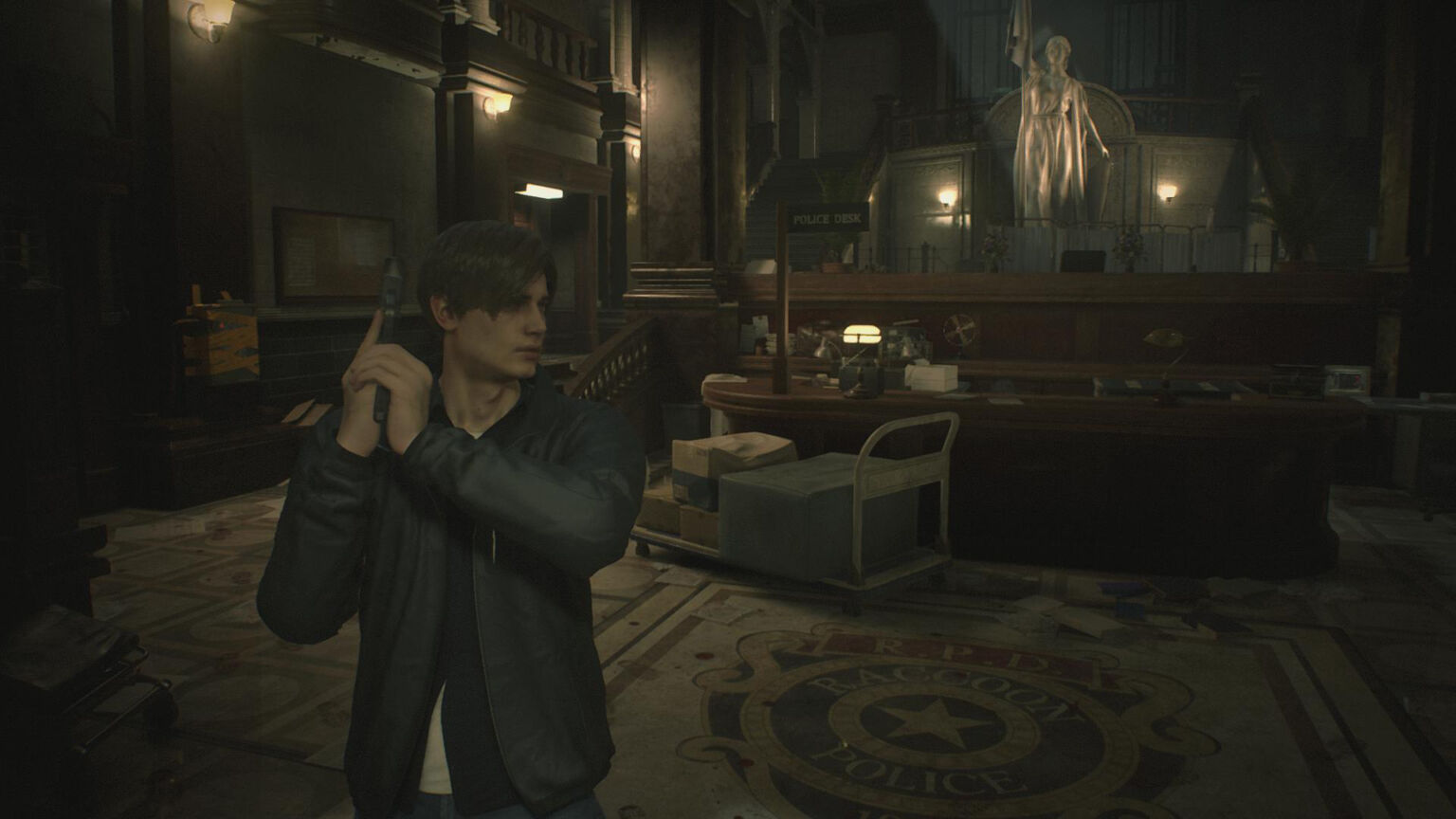 We now use the new Miami built-in benchmark of Hitman 2 which recently got patched into the game and our own custom time demo of Resident Evil 2.
We now use the new Miami built-in benchmark of Hitman 2 which recently got patched into the game and our own custom time demo of Resident Evil 2.
Our testing platform is a recent install of Windows 10 64-bit Home Edition, and we are using a Core i7-8700K which turbos all 6 cores to 4.7 GHz, an EVGA Z370 FTW motherboard, and 16GB of HyperX DDR4 3333MHz. The games tested, settings, and hardware are identical except for the drivers being compared.
Test Configuration – Hardware
- Intel Core i7-8700K (HyperThreading and Turbo boost are on to 4.7 GHz for all cores; Coffee Lake DX11 CPU graphics).
- EVGA Z370 FTW motherboard (Intel Z370 chipset, latest BIOS, PCIe 3.0/3.1 specification, CrossFire/SLI 8x+8x), supplied by EVGA
- HyperX 16GB DDR4 (2×8 GB, dual channel at 3333 MHz), supplied by HyperX
- RTX 2060 6GB Founders Edition, stock Founders Edition clocks, on loan from NVIDIA
- 480 GB Team Group SSD
- 1.92 TB San Disk enterprise class SSD
- 2 TB Micron 1100 SSD
- Seasonic 850W Gold Focus power supply unit
- EVGA CLC 280mm CPU water cooler, supplied by EVGA
- Onboard Realtek Audio
- Genius SP-D150 speakers, supplied by Genius
- EVGA DG-77, mid-tower case supplied by EVGA
- Monoprice Crystal Pro 4K
Test Configuration – Software
- Nvidia GeForce 417.54 and 418.81 WHQL drivers are used for the RTX 2060.
- VSync is forced off.
- AA enabled as noted in games; all in-game settings are specified
- Gaming results show average frame rates in bold including minimum frame rates shown on the chart next to the averages in a smaller italics font.
- Highest quality sound (stereo) used in all games.
- Windows 10 64-bit Home edition. All DX11 titles were run under DX11 render paths. DX12 titles are generally run under the DX12 render path unless performance is lower than with DX11. Three games use the Vulkan API.
- Latest DirectX
- All 40 games are patched to their latest versions at time of publication.
- MSI Afterburner, latest beta.
- OCAT, latest version
- Fraps, latest version
40 PC Game benchmark suite & 4 synthetic tests
Synthetic
- Firestrike – Basic & Extreme
- Time Spy DX12
- Port Royal – Default and DLSS (1920×1080)
- Superposition
DX11 Games
- Grand Theft Auto V
- The Witcher 3
- Fallout 4
- Rainbow Six Siege
- Battlefield 1
- Resident Evil 7
- For Honor
- Ghost Recon Wildlands
- Mass Effect: Andromeda
- Prey
- Hellblade: Senua’s Sacrifice
- Project CARS 2
- Middle Earth: Shadow of War
- Total War: Warhammer II
- Destiny 2
- Star Wars: Battlefront II
- Kingdom Come: Deliverance
- Final Fantasy XV
- Far Cry 5
- The Crew 2
- Assassin’s Creed: Odyssey
- Call of Duty: Black Ops 4
- Hitman 2
- Resident Evil 2
DX12 Games
- Tom Clancy’s The Division
- Ashes of the Singularity: Escalation
- Hitman
- Rise of the Tomb Raider
- Deus Ex Mankind Divided
- Gears of War 4
- Civilization VI
- Sniper Elite 4
- Forza 7
- Total War: Warhammer II
- Shadow of the Tomb Raider
- Battlefield V
- Just Cause 4
- Strange Brigade
Vulkan Games
- DOOM
- Wolfenstein: The New Colossus
- Strange Brigade
NVIDIA Control Panel settings
Here are the NVIDIA Control Panel settings.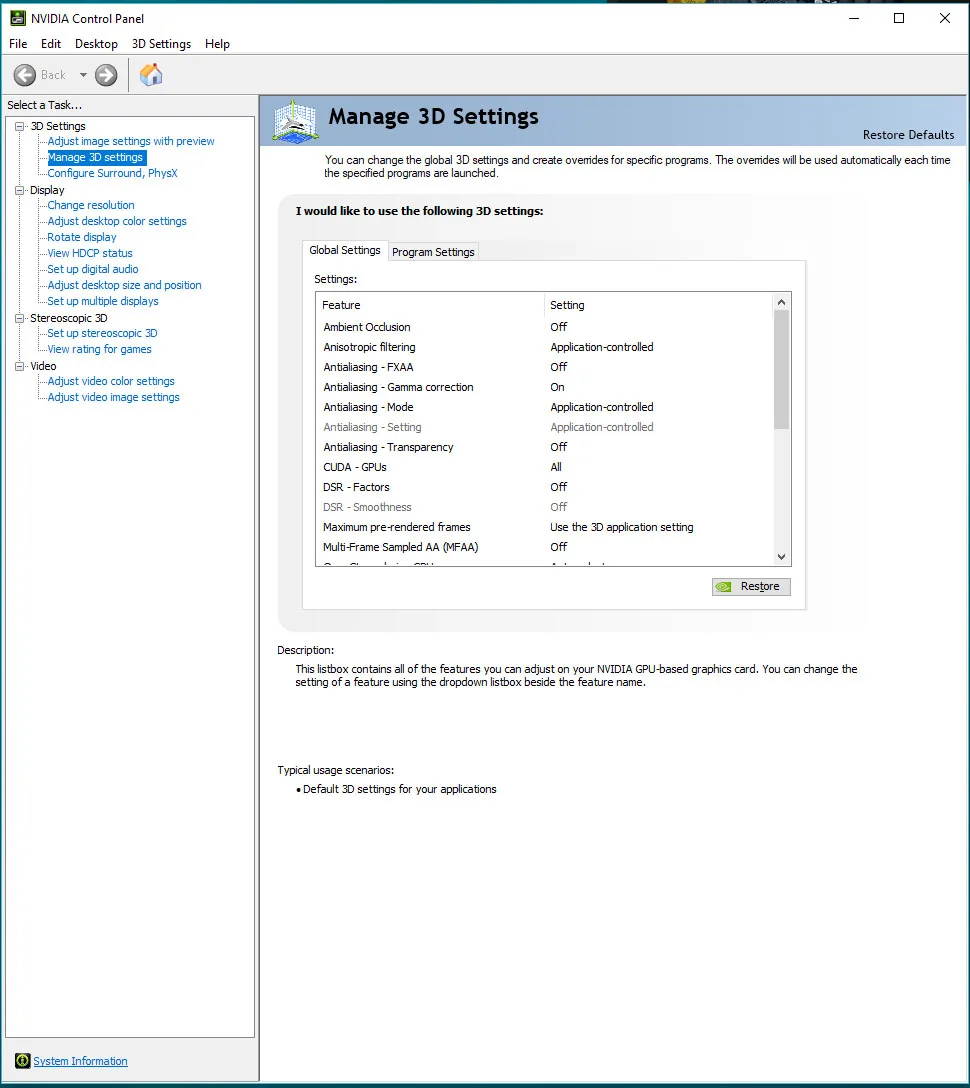
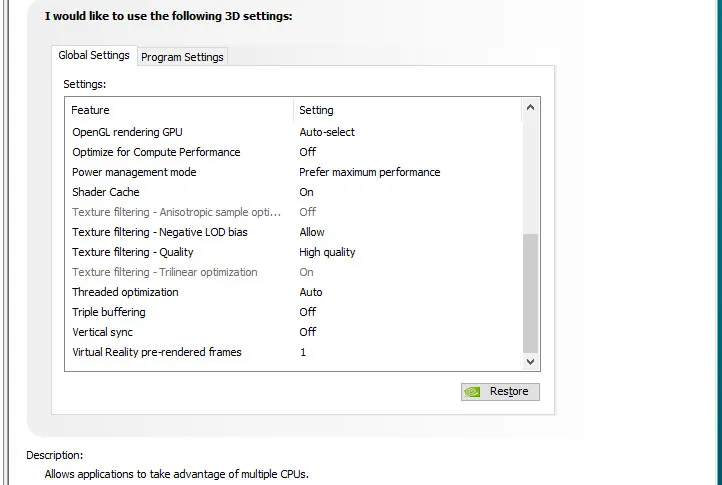 We used MSI’s Afterburner to set the RTX 2060’s highest Power and Temperature targets. By setting the Power Limits and Temperature limits to maximum, it can maintain its maximum clocks without throttling.
We used MSI’s Afterburner to set the RTX 2060’s highest Power and Temperature targets. By setting the Power Limits and Temperature limits to maximum, it can maintain its maximum clocks without throttling.
Game Ready GeForce 418.81 WHQL Drivers
This latest GeForce Game Ready 418.81 driver introduces public support for the new Port Royal DLSS Feature test. The download links for the latest GeForce 418.81 drivers can be found starting here. The release notes can also be found here. The included highlights below are from NVIDIA’s website.
Game Ready Drivers provide the best possible gaming experience for all major new releases, including Virtual Reality games. Prior to a new title launching, our driver team is working up until the last minute to ensure every performance tweak and bug fix is included for the best gameplay on day-1.
Gaming Technology
Includes support for new GeForce RTX laptops, and delivers the optimum performance in Futuremark’s 3DMark Port Royal benchmark, which has just added a new feature test for NVIDIA Deep Learning Super Sampling (DLSS).
Let’s head to the charts to compare the driver changes from the GeForce 417.54 drivers which were the RTX 2060 launch drivers to the latest GeForce 418.81 drivers.
The Summary Chart
Below are the summary charts of 40 games and 4 synthetic tests. Forty games are used to compare the performance changes for the RTX 2060 FE from its launch 417.54 GeForce drivers to the most recent 418.81 drivers. The highest settings are always chosen and the settings are listed on the charts. The benches were run at 1920×1080 and at 2560×1440. Open each chart in a separate window or tab for best viewing.
Most results show average framerates and higher is better. Minimum framerates are next to the averages in italics and in a slightly smaller font. A few games benched with OCAT show average framerates but the minimums are expressed by the 99th percentile frametimes in ms where lower numbers are better.
The first column shows the RTX 2060 FE’s performance on the latest 418.81 driver. Columns two represents the launch 417.54 driver. Wins between drivers are shown in yellow text. If both sets of results are equal, they are both shown in yellow text. An “X” means the benchmark was not be run.

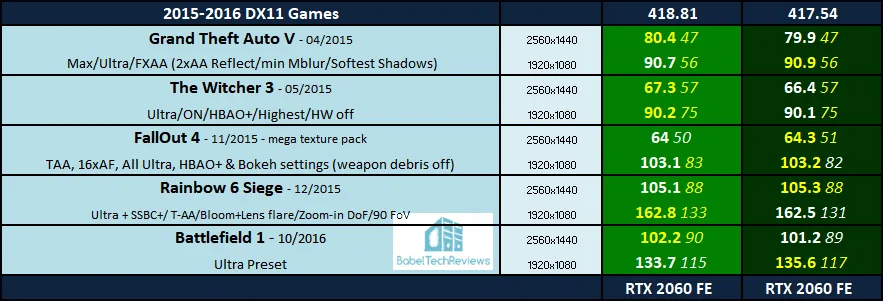
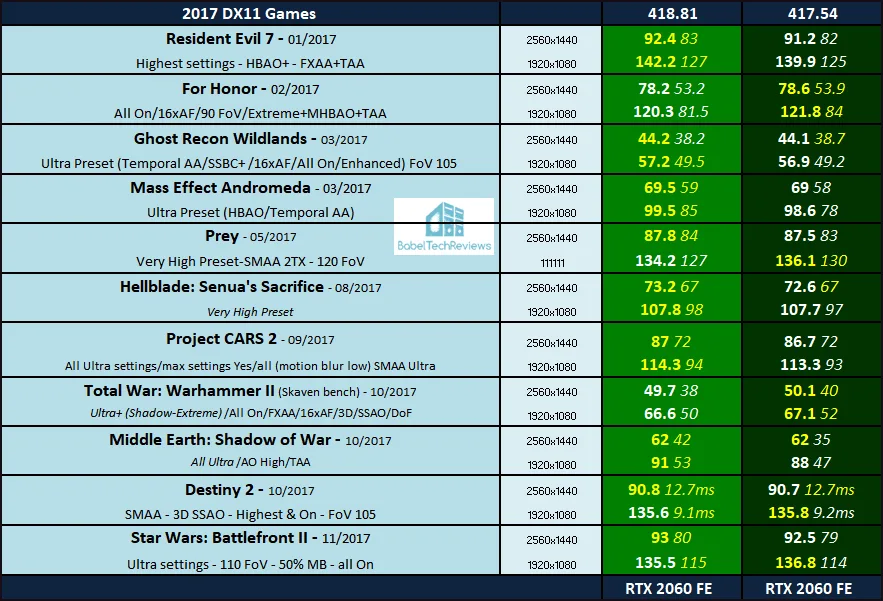
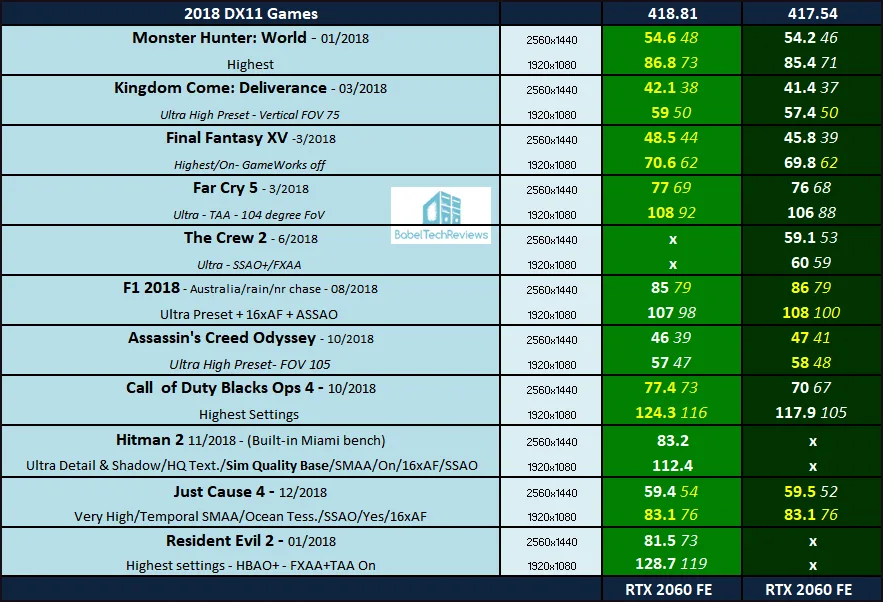

 We see mostly incremental performance improvements between the latest drivers and the oldest driver, although the increases are generally as minor as any regressions. However, in a few cases such as Call of Duty: Black Ops 4 and to a lesser extent, Gears of War 4 and Shadow of the Tomb Raider, we see some significant performance increases with the newest drivers for the RTX 2060 since it launched.
We see mostly incremental performance improvements between the latest drivers and the oldest driver, although the increases are generally as minor as any regressions. However, in a few cases such as Call of Duty: Black Ops 4 and to a lesser extent, Gears of War 4 and Shadow of the Tomb Raider, we see some significant performance increases with the newest drivers for the RTX 2060 since it launched.
We note that one game, The Crew 2, refused to run in fullscreen mode and it tanked our framerates. 3DMark’s Port Royal DLSS feature test shows that DLSS gains significant performance over not using it.
POLL: Do you want to see competing cards compared in future driver reviews?
In this continuing poll would like to ask BTR’s readers if you want to see the performance of competing cards compared in future driver performance analyses? For example, would you like to see the performance of NVIDIA cards, the RTX 2060 also compared with the AMD RX Vega 56? Please use Disqus to comment below, and/or use our poll.
[poll id=”2″]
Let’s head to our conclusion.
Conclusion
We would recommend upgrading to the latest Game Ready 418.81 WHQL driver from any older driver set because there are generally stability or performance advantages for the newest games, depending on which game you are playing. We found the latest drivers to be very stable overall, and we experienced no major performance issues while benching or playing any of our 40 games except with The Crew 2.
Both of our tested drivers are from the same Game Ready family and we mostly see incremental changes from the RTX 2060 launch drivers although in a few cases, they are significant. These drivers are certainly worth trying especially if you want to check out the 3DMark Port Royal ray tracing benchmarks including DLSS performance on versus off.
We received an EVGA NU Audio card for review recently. We didn’t want to test it with headphones only, so we purchased a decent pair of Edifier active bookshelf speakers to give you a better review. So far, we like the speakers, and we are giving the sound card a thorough critical “golden ears” music and gaming audition by also using Grado headphones, plus Logitech G PRO and HyperX Cloud Headsets. Expect the review before next week.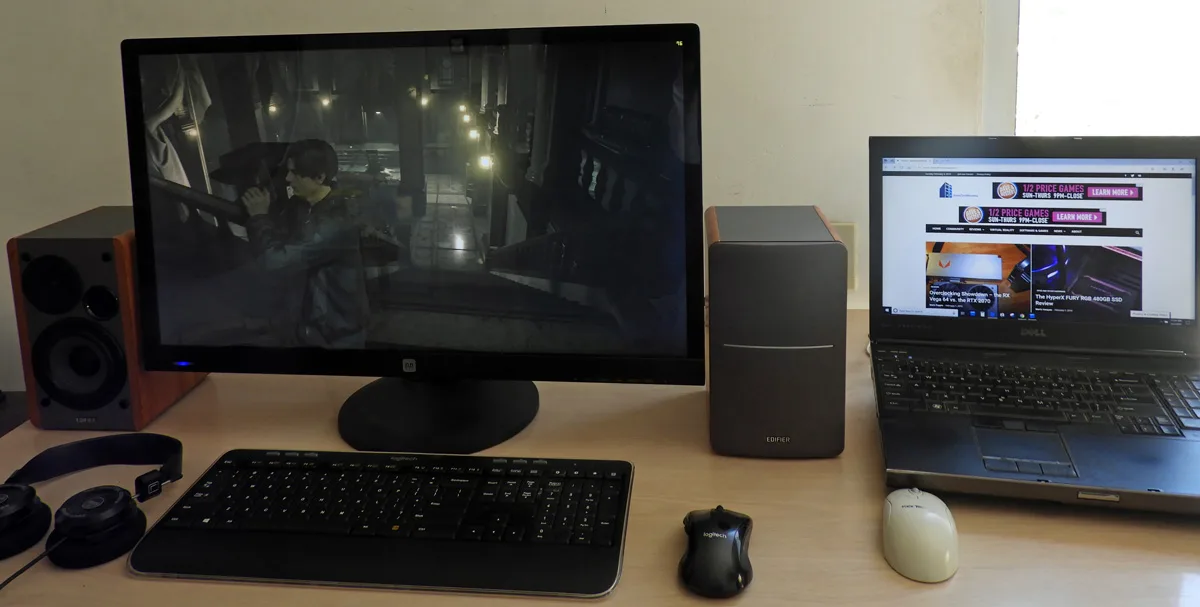
Don’t forget to vote in our poll and let us know if you want to see AMD competing cards included in future NVIDIA driver performance analyses.
Happy gaming!